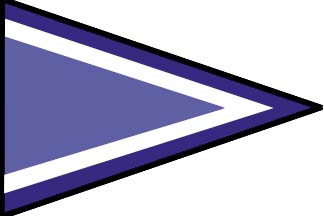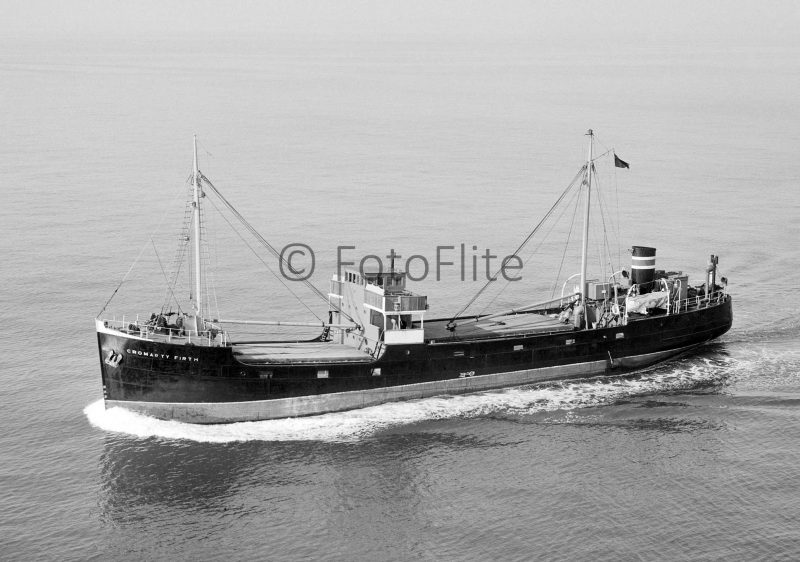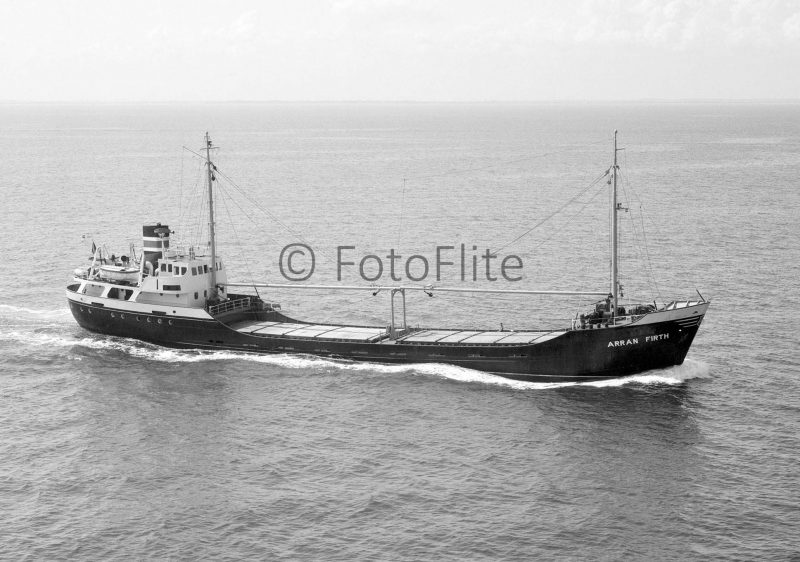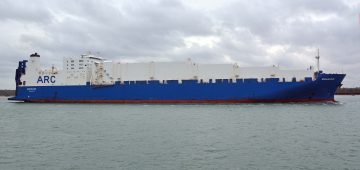The ‘Firth’ Coasters

 Gillie & Blair Ltd. have owned and managed coasters for over a century from an office in Newcastle. As a very young man, George Tulloch Blair set up in business in November, 1911 as a shipbroker and ship manager in the Baltic Chambers on Newcastle Quayside. He purchased the Glasgow coaster Ferrum of 271 grt shortly afterwards from the British Coasting Steamship Co. Ltd. (Young & Gillespie, managers) for £3,500. She had been laid up for sale on the Clyde at the Forth & Clyde Canal at Bowling for eighteen months, and the young Newcastle ship manager then registered her under the Ferrum Steamship Co. Ltd. to trade with coal from small North East Coast ports such as Seaham, amble and Berwick to London and the Channel ports. She was able to trade to the Thames at reduced London port dues due to having a very low net tonnage.
Gillie & Blair Ltd. have owned and managed coasters for over a century from an office in Newcastle. As a very young man, George Tulloch Blair set up in business in November, 1911 as a shipbroker and ship manager in the Baltic Chambers on Newcastle Quayside. He purchased the Glasgow coaster Ferrum of 271 grt shortly afterwards from the British Coasting Steamship Co. Ltd. (Young & Gillespie, managers) for £3,500. She had been laid up for sale on the Clyde at the Forth & Clyde Canal at Bowling for eighteen months, and the young Newcastle ship manager then registered her under the Ferrum Steamship Co. Ltd. to trade with coal from small North East Coast ports such as Seaham, amble and Berwick to London and the Channel ports. She was able to trade to the Thames at reduced London port dues due to having a very low net tonnage.
The second coaster Argentum of 246 grt was purchased in 1912 and is remembered for her very long arctic voyage with stores and machinery to Svalbard (Spitzbergen), over one thousand miles north of the North Cape of Norway. More coasters were subsequently purchased with capital raised for the following new companies:
Ferrum Steamship Co. Ltd. (1911)Border Coasters Ltd. (1913)
Cheviot Coasters Ltd. (1915)
Whinstone Shipping Co. Ltd. (1915)
Border Shipping Co. Ltd. (1918)
Firth Shipping Co. Ltd. (1923)
Northern Coasters Ltd. (1924)
The last two of these companies were to prove the most enduring, with the Firth Shipping Co. Ltd. lasting until 1981. J.A. Blair joined the company early in 1914 and became a partner in the early 1920s as Gillie & Blair Ltd. and continued working in the company until his death in 1951. There were only two war losses among the little fleet of five owned and five managed coasters during World War I as Netta and Ferryhill were both captured and sunk by U-boats while on government service off Cape d’Antifer near Le Havre. All but two of the fleet, Deerhound and Cragside, had been requisitioned for government service. The managed coasters were Glencona, Glenrose and Glenbrook for ‘T’ Steam Coasters Ltd. of Newcastle, Rhenass for R. Jolson & Co. Ltd. of West Hartlepool, and Gleno for R. Emmerson of North Shields.
an interesting experiment was tried in 1918 by George Tulloch Blair when he purchased five small sailing ships, the brigantine aneroid of 229 grt, the schooners Marion, Hannah ransom and Moorside, and the barquentine ibis, to trade from the Channel ports to French Biscay ports with Devon crews, the only men left at that time with the necessary small sailing ship experience. They were paid on a voyage basis and the young Newcastle ship manager was surprised that in the majority of voyages a small profit was made. Moorside was purchased as Betty Russel and had been built at Barrow back in 1864, and it was decided because of her age to fit her with an auxiliary engine. This was done at Fowey but was much more expensive than envisaged and she was unfortunately soon wrecked on 29th April, 1919 north of Caister while on a voyage from Treport to the Tyne. The four remaining sailing ships were then sold off by 1920/21.
A New Coasting Fleet
The first coaster with a ‘Firth’ name was purchased in 1918 from Glasgow owners as Moray Firth of 341 grt, and was soon joined by the purchased Liverpool coaster Squadron of 362 grt and renamed as Solway Firth. Eleven new steam coasters were then delivered for a new company g. T. gillie (Coal Exporters) Ltd. from various shipbuilders at Aberdeen, Ardrossan, Hull and South Shields and to other companies managed by Gillie & Blair Ltd. between 1919 and 1921. The cost of each coaster was around £40,000 and the early post-war boom in freight rates had encouraged this, but when the subsequent crash came a year or so later, three of them had to be sold on to the general Steam Navigation Co. Ltd. of London to stay in business. One more coaster was sold to the Point of Ayr colliery in North Wales from a high point of fifteen coasters owned in 1921. After freight rates had stabilised, three new and seven purchased coasters then joined the fleet between 1923 and 1929.
One of these new coasters was the engines and bridge aft Royal Firth of 411 grt completed in 1921 at Hull. She was chartered in July, 1926 to bring the new ‘super’ transatlantic telegraph cable ashore at Sennen Cove in Cornwall by the Commercial Cable Company of America. Their big Tyne built cablelayer John W. Mackay of 1922 laid the cable from Quidi Vidi at St. John’s (Newfoundland), and Royal Firth then took over the landward end of the cable just off Sennen Cove. This new ‘super’ cable gave an increased rate of transmission from 280 to 2,500 letters per minute, and the 1.5 miles of cable from royal Firth to the cable hut at the top of the beach at Sennen Cove weighed 45 tonnes. It was dragged by teams of horses and men in wild conditions to the cable hut and a new faster cable communication era with Canada and America was immediately begun. Stream Fisher of 471 grt was managed during 1927/28 for Tyne Coasters Ltd. of Newcastle, she had been built in 1891 for James Fisher & Sons Ltd. by McIlwaine and McColl of Belfast and sold in 1922.

The Newcastle coaster fleet in 1930 comprised Beauly Firth 489/20, Border Firth 469/19, Cromarty Firth 377/24, Moray Firth 541/27, Pentland Firth 490/19, royal Firth 411/21, Stronsa Firth 491/25 and the much larger Northern Firth of 1,950 grt built in 1921 as well as the managed Elvier 749/19 for I. Clemmetsen, bonded store owner of North Shields. The larger coasters could undertake longer voyages e.g. coal from the Tyne to Baltic ports returning with timber, coal from the Tyne to Continental and Biscay ports, Tyne to Reykjavik with coal and then loading a cargo of dried fish for Northern Spanish ports and returning north with iron ore. Portland stone had been transported to the Tyne for the construction of the new Tyne Bridge in 1928, a section of the record breaking pioneer turbine powered Turbinia of 1897 was transported from Tyneside to London in 1927, and two new rudders for the Cunard liners Berengaria and Aquitania had been transported from the Tees to Southampton earlier in the decade.

Northern Firth had been purchased in 1930 from J. & J. Denholm & Co. Ltd. of Glasgow as Willowpark, but remained laid up for the first three months of 1930 due to the severe fall in freight rates following the October 1929 Wall Street Crash. Northern Firth than sailed from the Tyne in May 1930 with coal on two voyages to the Mediterranean, followed by a year charter on the Australian coast, sailing with coal from the Tyne for Batavia in Java then ballast to Sydney (NSW) under the command of Capt. Todd with a Geordie crew. However, to comply with Australian law, the crew had to be sent home from Sydney and replaced by an Australian crew. Capt. Todd retained command and the ship was put under the Australian flag. A second year long charter was begun, but on 21st February 1932, Northern Firth was wrecked some 150 miles south of Sydney while on a voyage from Melbourne to Sydney after striking a submerged object and drifting ashore.
The four years from 1930 to 1933 inclusive were years of exceptionally depressed freight rates, and although half of the little fleet of seven coasters was kept employed no profits were made as the profit margin was very slim. Freight rates for deep sea tramps did not pick up very much before 1935, but for coasters a small rise began at the end of 1933. The ‘archdecker’ collier Eleveen of 2,600 dwt was another victim of the Depression, with her Newcastle owner W. Swanston going under into insolvency in 1933, and management was then given to Gillie & Blair Ltd. by the mortgagees for the next three years.
The new coaster Deemount of 569 grt was delivered in September 1933 from the Aberdeen yard of John Lewis & Sons Ltd., the fifth new ship for the Newcastle coaster fleet from this yard, and she soon began to trade more profitably with a variety of cargoes including Tyne coal to Aberdeen. She had the unusual layout of both bridge and engines aft, with her tall black funnel bearing a blue band between two thin white bands immediately behind the bridge. She had brown upperworks and a black hull with red boot topping. The Master had a cabin to starboard of the accommodation on the weather deck below the two deck chart room and bridge, with the Mate to port and a saloon in between, and the Chief Engineer, Second Engineer and the rest of the crew aft. She had two holds and two hatches with two small derricks for cargo handling on a single mast between the hatches.

The Lewis yard in Aberdeen then delivered Cromarty Firth of 538 grt in February 1937 for Northern Coasters Ltd. The latter was the first motorship in the fleet, although Arran Firth of 1921 had been fitted with a Bolinders hot bulb engine of 350 bhp. Cromarty Firth was fitted with a six cylinder oil engine by British auxiliaries Ltd. of Glasgow She was considered to be the ‘last word’ in modern motor coasters of her size, and was an excellent sea boat and had a lowering mast and funnel to go under Dutch bridges. However, the general improvement in freight rates was halted in 1938 with a low freight rate period and several ‘Firth’ coasters had to be laid up. Border Firth built in 1923 was sold in 1939 and renamed East Coaster, and Northern Firth built in 1920 and purchased in 1937 drifted ashore during 1939 and was sold to the James Lamont yard at Port Glasgow for rebuilding.
World War II
The Newcastle fleet on the outbreak of war in September, 1939 consisted of seven coasters in Border Firth 469/19, Cromarty Firth 538/37, Deemount 569/33, Moray Firth 541/27, Murrayfield 576/08, Stronsa Firth 491/25 and the managed Porthcarrack 406/24 for C.W. Dalling of Cardiff. Five of this fleet were requisitioned by the government for war service, while the two coasters that were not requisitioned were free to trade under licence and take cargoes at much increased freight rates. The German invasions of Norway, Denmark, Holland, Belgium and France by June 1940 denied Continental cargoes to the two ‘free’ ships, while at least one ‘Firth’ coaster carried British Expeditionary Force troop’s home from Dunkirk. Stronsa Firth took part in ‘Coal Scuttle Convoys’ through the Dover Straits with narrow escapes from the long distance German guns on Cape Gris Nez.
Two of the ‘Firth’ fleet became marine losses during 1942 with Moray Firth sold in the autumn of that year to London owners and lost shortly afterwards in collision to the northeast of Portknockie while on a voyage from London to Kirkwall. Murrayfield grounded on 7th April 1942 on the Shetland Islands while on a voyage from Lerwick to the Tyne, later slipping off into deep water and sinking. In February 1943, the old steam coaster Berryden of 506 grt, built in 1904 to carry coal to Aberdeen as Thrift, was managed for Robert Taylor & Sons Ltd. of Dundee until she was sold in the autumn of 1945 as uneconomical to operate after over forty years of service. The coaster Brightside 476/30 was then managed for this owner from 1945 to 1950. A small Danish coaster Merkur II was also managed during the war on behalf of the Ministry of War Transport.
Deemount under the command of Capt. John Mackintosh of Sunderland sailed from Plymouth on 5th June 1944 to Sword Beach on the British sector of the Normandy landings. She was part of the huge invasion force and had medical supplies and hospital stores on board and was thus one of the first ships to be unloaded. on one of her many voyages to the landing beaches she was ordered to Utah Beach in the American sector but had to ride out the severe gales in the lee of the Mulberry Harbour that had by then been constructed. Deemount was the first British ship into St. Vaast and also into St. Malo after they were cleared of mines. She then carried a number of urgent cargoes to Granville on the French coast east of the Chausey Isles and not far from St. Malo, but fortunately missed the German attack from Jersey on that port later in 1944 with several British ships sunk or damaged and the loss of many members of their crews. Capt. Macintosh was awarded the MBE for his bravery and continued as Master of Deemount until 1946 when he took command of Cromarty Firth of 1937 until he retired in 1950.
Cromarty Firth had for the first eighteen months of the war carried ammunition and stores from Crombie near Rosyth to Scapa Flow. However, while on requisition she was in the north of Norway during the German invasion of that country in April 1940 and survived several near misses from twelve hours of bombing in a small fjord in company with the anti-aircraft cruiser Cairo. She then received orders that more ammunition was required and sailed from Norway on the day before the final evacuation of British forces. She was running short of bunkers and was forced to take on unsuitable fuel from a tanker, which together with the aircraft carrier glorious was sunk during the next day by two German pocket battleships. Cromarty Firth somehow safely reached Scapa Flow, and later took ammunition to a West Highland loch in case of possible invasion. Cromarty Firth was then sent south under the command of Capt. Henry Bailey of South Shields in a convoy to Gibraltar in 1942. She arrived in North Africa shortly after the allied invasion, and was stationed at Algiers, Oran, Bizerta and Naples as an ammunition supply ship to the royal Navy. She had a top speed of only four knots after her hull had become fouled with eight inches of weeds when she made her final slow voyage from the Mediterranean, with empty ammunition boxes for home, in late 1944.
Post-War Years

The standard coasters Empire Seabrook and Empire Seablue of 518 grt were managed for the Ministry of War Transport from April 1945 for a few years after the end of the war. The keel of a new motor coaster was laid at the Aberdeen yard of John Lewis & Sons Ltd. at the end of 1945 and was completed as Moray Firth (3) of 567 grt and 740 dwt in 1946 and powered by a British Polar diesel engine. Deemount was renamed Olna Firth in 1945 and sold three years later in 1948 to the gem Line of William Robertson of Glasgow and renamed Tourmaline. A replacement for her followed in March, 1949 from the Greenock yard of George Brown & Company (Marine) Ltd. as Beauly Firth (3) of 553 grt and 750 dwt. Her sister Mount Blair followed two months later from the same yard for management by Gillie & Blair Ltd. for Robert Taylor & Sons Ltd. of Dundee.
The year of 1946 was a difficult year for the ‘Firth’ coasters in that coal cargoes were in short supply as the collieries had not yet got back into full working after the war. The severe winter weather of early 1947 meant that coal was in demand and freight rates were again high, but again coal was in short supply with cuts in electricity and severe rationing causing misery for all in that dreadful long winter. However, by the summer of 1947, the ‘Firth’ coasters were busily engaged in carrying timber from Germany to this country, and the motor coaster Cabourne of 525 grt came to Gillie & Blair Ltd. for management for Coastal Carriers Ltd. for the next seven years.
In the early morning of 12th august 1948, Moray Firth was some fifty miles off the German coast and sighted a blazing vessel. She altered course and found her to be a Swedish tanker, and with considerable difficulty, as the coaster could not be brought alongside the blazing vessel, the Master and twelve crew were rescued, two of them later dying from their burns. Capt. Bailey proceeded at full speed to land the injured men at Bremen as they were in urgent need of medical attention. A German steamer managed to take the stricken vessel in tow later in the day and reached port, and a considerable salvage sum was paid to her owners and crew. Moray Firth received nothing for her valiant rescue of badly injured men, but had upheld the highest traditions of the sea on humanitarian grounds.

The first nine months of the year of 1949 saw weak freight rates for coasters with some British coasters and one of the ‘Firth’ fleet laid up at times. Freight rates picked up in the autumn again, and timber cargoes from German and Bay of Biscay ports were abundant. Deep sea ships saw high freight rates in 1950 due to the Korean War, and the ‘Firth’ fleet of coasters had a mixed year with the autumn giving high rates for cargoes of coal from the Tyne to the Continent. The steam coaster Tynecastle of 570 grt and 670 dwt, completed in November 1924 as Turquoise for William Robertson of Glasgow, was purchased by Castle Coasters Ltd. of Edinburgh in 1950 and came to Gillie & Blair Ltd. for management for nine years. The year of 1951 saw a bigger improvement in freight rates with an increase in Ministry schedule rates from March for coasters employed on British coastal cargoes. However, trading results in 1952 were poor due to a sudden drop in freight rates, for all of the Newcastle ‘Firth’ coasters and most other British coaster owners.

During 1953, the three owned and four managed Gillie & Blair Ltd. coasters all found reasonable employment except during the summer months when charters were notably unforthcoming. British shipbuilding costs had risen out of all proportion to freight rates, and the Newcastle owners had to go overseas for the first time for a new coaster. The yard chosen was Bodewes of Hoogezand and Niemegen in Holland and in March, 1955 Pentland Firth (3) of 780 dwt was delivered to Northern Coasters Ltd., followed by Olna Firth (2) of 780 dwt in February, 1957 for the Firth Shipping Co. Ltd., and Moray Firth iv of 613 grt and 850 dwt in January 1960 for the Firth Shipping Co. Ltd. They were raised quarterdeckers with two holds, two derricks and two masts with the aft mast directly in front of the bridge. All three coasters were powered by eight cylinder four stroke single acting Werkspoor oil engines giving service speeds of 10.5 knots.

In 1958, the four owned coasters, Beauly Firth of 1949, Moray Firth of 1946, Pentland Firth of 1955, and Olna Firth of 1957, together with the managed coasters Glenapp Castle, Mount Blair, and Tynecastle experienced high freight rates and plenty of cargoes of Tyne coal to the Continent. Moray Firth was sold in 1959 to the Aberdeen Coal & Shipping Co. Ltd. and renamed Ferryhill and continued to carry coal from the Tyne and Blyth to Aberdeen. Beauly Firth was sold in 1962 to P. H. Bouchard of Canada and renamed Nelson B, but sank five years later on 14th January 1967 six miles west of Cape St. Mary (NS) while on a voyage from Sydney (CB) to Weymouth (NS). A replacement second hand more modern motor coaster was found in the Dutch built Alfa of 531 grt and was renamed Arran Firth in 1962.
The founder George Tulloch gillie died during 1963, with John Tulloch gillie taking over the reins of management. The managed coaster business was now increased, with the management of Olna Firth retained in 1967 after her sale to S. Williams of Liverpool, as well as Wilks of 422 dwt built in 1969 by Clelands for Eggar Forrester Ltd. of London, and four feeder coasters for Blue Star Line in Orwell Star (renamed Orwell in 1965), Waveney Star (renamed Waveney in 1965) and Crouch and Deben built in 1966, as well as the fleet of Mardorf, Peach & Co. Ltd. including Camilla Weston, Gretchen Weston, Catrina Weston, Jana Weston, Sophia Weston and Mary Weston, all coasters of 500 grt and 800 dwt and built between 1966 and 1973. Camilla Weston ex Crouch sank on 15th February 1984 off Happisburgh, Norfolk after being in collision with Laissasee while at anchor in fog. She was on a voyage with grain from Tilbury to Leith.

The owned fleet of four coasters in 1963 of Pentland Firth, Olna Firth, Arran Firth and Moray Firth IV was reduced by the sale of three coasters to only Moray Firth IV by 1969, with Pentland Firth going to Greek owners in 1967 and Arran Firth to the Shamrock Shipping Co. Ltd. of Larne without change of name. All four had been used in the search for North Sea oil, with prospecting taking place during 1963/66 to both the north and south of the Tyne. Long seismic cable was paid out over the stern of one coaster, with explosives stored in the holds of another coaster and dropped some distance away into the sea to hopefully give the ‘dome’ shape of an underwater oilfield on the recording apparatus. Moray Firth IV was also on charter to British Insulated Callendar’s Cables Ltd. (BICC) in order to lay an underwater electricity cable from mainland Argyll to Islay and Jura in 1963, a length of six miles of cable being used with floats at either end.
Coasters Managed To The Millennium

In 1976, Gillie & Blair Ltd. were managing twelve coasters in the range from 500 dwt to 1,200 dwt for a variety of clients including Mardorf, Peach & Co. Ltd., Eggar Forrester Ltd., Stag Line Ltd. with Kielder Stag of 1,017 dwt and later Silloth Stag of 1,184 dwt, and Ganton, Turnberry and St. Andrews for Usborne & Son of London, and Tarmac I for Tarmac roadstone Holdings Ltd. The owned Moray Firth IV was sold in 1981 to Anro European Ltd. of Cardiff and renamed Anro Pioneer and later to Capt. M.F. McCarthy of Cardiff and was broken up in June 1985. The former Pentland Firth of 1955, Olna Firth of 1957 and Arran Firth of 1957 were, however, still in service with foreign owners ten years later in 1995.

Management was then obtained in 1982 of the recently purchased drill ship Wimpey Geocore, the former Everard coaster William J. Everard built in 1963. She was managed throughout the 1980s while engaged on National Coal Board (NCB) charters for proving the extent of coalfields off the North East Coast. She was then laid up in the Tyne at Newcastle, later moving around to the Wear where she was sold and renamed Seaburn girl, and then departed in 1992 to begin a new career in Nigeria as Ecowas Trader I. The Newcastle office of Gillie & Blair Ltd. was then managing three coasters in the late 1980s in ardent of 1,180 dwt built in 1981, Marianne Norcoast of 1,016 dwt built in 1971, and Millac Star I of 1,570 dwt built in 1974.

John Tulloch gillie died in 1990 and the management was taken over by the brothers Geoff and Steve Gillie. The motor coaster river Dart of 825 dwt was managed for Ensign Express Shipping Ltd. of London from 1990, as well as Craigmore of 1,972 dwt for Cobo Shipping Ltd., and Rosebank of 1,694 dwt for Boddingtons Shipping Ltd. of London. River Dart had been built in 1981 at Ringkobing for near Continental trading between the Bay of Biscay and the Baltic, Craigmore had been built in 1966 by R. Dunston Ltd. at Hessle for Cawoods of Belfast, and Rosebank had been built in 1982 as Shamrock Endeavour at Hoogezand in Holland. A brisk trade for Gillie & Blair Ltd. in Continental steel cargoes into Whitby was operated during this time, with distribution by lorry to steel stockholders throughout Britain or to other ports for transhipment from the west coast.
Current Fleet

River Dart was sold to other British owners, and then in 2009 to Simi Lines Shipping of Piraeus and she was renamed Panormitis. By that time, Sea Hunter of 3,000 dwt, Sea Eagle of 2,535 dwt (the former Balleygarvey and Shoreham) and Sea Hawk of 2,850 dwt were being operated by Gillie & Blair Ltd. while managed by Torbulk Ltd. of Grimsby. Today, Torbulk Ltd. has a dozen coasters listed, some registered under Boddingtons Shipping Ltd. and owned by Robert Boddington of Braintree in Essex, and others under the Firth Shipping Co. Ltd. and Northern Coasters Ltd. and owned by Gillie & Blair Ltd. a fleet of seven owned or managed coasters with ‘Sea’ names up to 3,710 dwt is operated by Gillie & Blair Ltd. in Sea Hawk of 2,850 dwt built in 1989 by Damen in Holland, Sea Melody of 3,710 dwt built in 1994, Sea Hunter of 3,000 dwt built in 1990, Sea ruby of 2,100 dwt ex Union Ruby ex Hoo Larch built in 1992, Sea Mithril of 2,100 dwt ex Bowcliffe built in 1992, Sea Kestrel of 2,100 dwt ex Hoo Kestrel built in 1993, and Sea Harmony of 2,100 dwt. Hertfordshire of 2,490 dwt built in 1995 as Atair by Slovensko Lodenice at Komarno and purchased by Bibby Line Ltd. of Liverpool in 2006 is also managed.
The holds and decks of this fleet are strengthened for the carriage of steel coils, containers, heavy flexible pipe reels etc, and are fitted for the carriage of hazardous cargo e.g. ammonium nitrate. This fleet are chartered out for voyages in Northern Europe, the Baltic and the Mediterranean for the carriage of coal, timber, wheat, barley, fertilizer, aggregates, animal feed, steel coils and beams, potash, salt, clay and other bulk cargoes as well as project cargo up to a maximum weight limit.

Very large industrial items weighing in at hundreds of tonnes are regularly handled by the Project Cargo Department. These have included power station equipment from the Tyne to Iraq over a one year period in loads ranging up to 300 tonnes, sub-sea equipment from the Tyne factory of Wellstream Ltd. to many countries including in the Far East, numerous transformers ranging from 80 tonnes to 275 tonnes in weight, six crawler cranes and associated equipment from Liverpool to Algeciras, twelve pipe rack modules shipped from Blyth in four chartered vessels, and the dismantling of a large sawmill in Scotland with the sections transported to Blyth where they were loaded and securely lashed on to a chartered vessel for export to Estonia. Heavy lift ships are regularly chartered in on time charter to carry this type of project cargo.
The former Swan Hunter Shipbuilders yards at Wallsend and Walker have been completely cleared over recent years of cranes, fabrication shops, engine building shops and other facilities in order for the regeneration of industry to take place e.g. in the offshore industries with companies such as Bridon Ltd. already on site manufacturing flexible pipe, cable and rope. Gillie & Blair Ltd. were asked to source and charter geared multipurpose tonnage to ship five full cargoes to Mumbai in India. Typical dismantled cargo into small items included cranes, both fixed and mobile, dismantled fabrication shops, steel fabrication and bending equipment, together with containers packed full of useful tools and loose items to be reused in an indian shipyard at Mangalore. A total of 7,500 tonnes of cargo was shipped in five vessels and all five cargoes were loaded and discharged under the supervision of a cargo superintendent and a surveyor after safely reaching their destination.
Gillie & Blair Ltd. also operate a ship agency covering the ports of Tyne, Blyth, Wear, Seaham, West Hartlepool and the Tees. The company blue pennant houseflag has a dark blue outer triangle with a light blue inner triangle bordered in white. The centenary of the company was celebrated during 2011, and during that century a grand total of over one hundred owned and managed coasters has been operated, a proud achievement indeed.
I wish to sincerely thank Steve and Geoff Gillie, and their excellent website www.gillieblair.com.
Comments
Sorry, comments are closed for this item